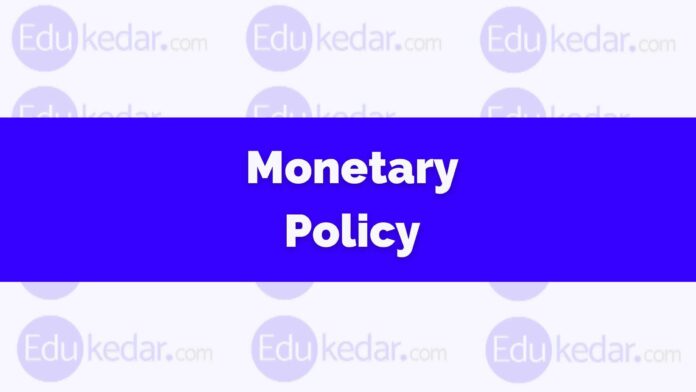The economic growth of any country depends on how effective and efficient its monetary policy or fiscal policy is. Both monetary and fiscal operations have repercussions on the whole economy.
So in the article, we will discuss what is monetary policy, its meaning, objectives, and tools used by the central banks to influence the economic trends of a nation.
► What is Monetary Policy?
Monetary policy refers to the use of instruments or tools within the control of the Central Bank. The effective use of policy instruments influences the level of aggregate demand for goods and services or influences the level of aggregate demand for goods and services.
◉ Monetary Policy Meaning
The Monetary Policy simply means a policy as a discretionary act undertaken by the central bank in a country to influence.
- The money supply
- Rate of interest
- Price stability and growth
◉ Definition of Monetary Policy
The Monetary policy can be defined as the policy that operates through the variation in interest rate, availability, and cost of credit. These variations affect the demand or supply of credit in the economy and the level and nature of economic activities.
Monetary Policy is formulated and executed by the Reserve Bank of India to achieve specific objectives like the supply of money, and cost of money or the rate of interest, with a view to achieving particular objectives.
► Monetary Policy in India
According to RBI Governor Dr. D. Subba Rao,
“The objectives of monetary policy in India are price stability and growth. These are pursued through ensuring credit availability with stability in the external value of rupee and overall financial stability.”
✔ If RBI increases the Interest Rate (+)
Borrowing from RBI becomes expensive ➜ banks will borrow less from RBI ➜ less credit will be provided by banks to borrowers ➜ the money supply will decrease ➜ People have less money to expand ➜ Demand for goods and services decrease ➜ Inflation decreases.
✔ If RBI decreases the interest Rate (-)
Borrowing from RBI become cheaper ➜ Banks will borrow more ➜ More credit is available for borrowers ➜ Money supply will increase ➜ Increase in economic activity ➜ Employment generation
► Objectives of Monetary Policy
- Price Stability
- Boost Economic Growth
- Equal income Distribution
- Stable Exchange Rate
- Inflation Control
- Better Standard of Living
- Balance of Payment (BOP)
- Promote Export and substitute imports
Now let’s discuss all the objectives in a more detailed manner.
✔ 1. Price Stability
In a current globalized world, the price of commodities is very volatile due to internal and external factors therefore price stability is very desirable for both developed and developing nations.
Price stability prevents the economy from the uncertainties caused by inflation.
✔ 2. Boost Economic Growth
Monetary policies are a very important determinant of business prospects and investment decisions.
Policy decisions by RBI affect the demand and supply of money which is very crucial for the industrial and commercial sectors of the country.
✔ 3. Equal Income Distribution
Affordability and accessibility to credit to the poor section of society help in the redistribution of income. The distribution of income results in wealth creation among the weaker section of society.
✔ 4. Stable Exchange Rate
The increase in international trade and dependence on foreign countries for goods and services causes exchange rate volatility which affects the value of a domestic currency with respect to foreign currency mainly the dollar. So stabilizing Extrem solitarily in the exchange rate can be done with the help of monetary policy
✔ 5. Inflation Control
The most prominent objective of a monetary policy is to control inflation, with the use of instrument tools central bank can increase or decrease the supply of money in the economy,
✔ 6. Better Standard of Living
Control over inflation and availability of cheap credit help the weaker or vulnerable section of society in wealth generation.
Monetary policy influences the rate of investment in the country which intensifies economic activities and generates a large number of employment opportunities.
✔ 7. Balance of Payment (BOP)
As global trade is strengthening the imports and exports of goods and services increase immensely which added pressure on forex reserves.
These results need more forex reserves to fulfill the import need of a nation, so RBI uses open market operation to maintain the required forex reserves.
✔ 8. Promote Export and substitute imports
By providing cheap loans to export-oriented industry, the monetary policy encourages the promotion of export which also help in improving the balance of payment and enhancing the forex reserve.
Also Read : Primary Sector of Economy
Also Read : Secondary Sector of Economy
Also Read : Tertiary Sector of Economy
► Instrument of Monetary Policy
These nstruments are divided into two categories that are as follows;
- Quantitative Instruments
- Qualitative Instruments
✔ 1. Quantitative Instrument
- Repo Rate
- Reserve Rate
- Standing Liquidity Ratio
- Marginal Standing Facility
- Bank Rate
- Open Market Operation
✔ 2. Qualitative Instrument
- Credit Rationing
- Margin Requirement
- Moral Suasion
- Direct Action
Must Read : Instrument of Monetary Policy (in detail)





